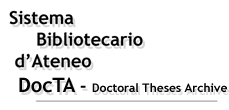|
|
DocTA - Doctoral Theses Archive >
Tesi di dottorato >
SCUOLA DI DOTTORATO IN SISTEMA AGRO-ALIMENTARE >
Citazione:
Utilizza queste indicazioni per citare o creare un link a questo documento.
|
Fontanella, Maria Chiara. "Application of different techiniques for Arsenic determination in human food chain: from groundwater to dining table", Università Cattolica del Sacro Cuore, XXV ciclo, a.a. 2011/12, Piacenza, [http://hdl.handle.net/10280/1958].
|
| Titolo: | Application of different techiniques for Arsenic determination in human food chain: from groundwater to dining table |
| Autore/i: | FONTANELLA, MARIA CHIARA |
| Tutor: | BEONE, GIAN MARIA
CAPRI, ETTORE |
| Coordinatore: | ASTORRI, ROMEO |
| Lingua: | ENG |
| Abstract in italiano della tesi: | Lo scopo della tesi è di caratterizzare i rischi per la salute umana, che derivano dall’inquinamento delle acque (acque sotterranee) e dal cibo (riso) tramite l’applicazione e lo sviluppo di nuove tecniche analitiche. La tecnica “diffusive gradients in thin films (DGT)” con resina a base di ferrihydrite, è stata studiata per l'accumulo delle forme inorganiche (As(III) e As(V)) e organiche (DMA(V) e MMA(V)) di Arsenico in matrici acquose. I DGT sono stati applicati su campioni di acque sotterranee, raccolti in sei diverse città del Nord Italia, dove la concentrazione di As è molto alta. Antimonio (Sb) è associato all’As in diversi studi perché le proprietà fisiche e chimiche di questi due elementi sono simili, ed esso è stato recentemente riconosciuto come contaminante dell'acqua. In questa tesi per la prima volta sono state riportate le prestazioni dettagliate dei DGT con ferrihydrite, impiegati in soluzioni acquose di Sb(III) e Sb(V). L’analisi delle forme chimiche di Sb(III) e Sb(V) in campioni acquosi è stata realizzata con l’applicazione della diluizione isotopica. In generale il riso, a differenza di altri prodotti alimentari di origine terrestre, contiene quantità significative di Arsenico inorganico. L’analisi della speciazione di As è stata realizzata in 70 campioni di riso italiano, rappresentativo di diversi tipi di coltivazione. Le forme più abbondanti nel riso erano As(III) e DMA(V). Inoltre è stato interessante studiare la localizzazione dell’As nel chicco di riso, sottoposto a diversi processi di lavorazione (risone, riso integrale e lavorato con o senza parboiling), perché sia la distribuzione che la presenza delle diverse forme chimiche nel chicco sono fattori chiave che controllano la biodisponibilità del contaminante. La distribuzione dell’ As nei chicchi di riso di due varietà (Gladio e Ronaldo) sottoposti a diversi processi, è stato determinato con Laser Ablation ICP-MS. In realtà il contenuto di As era più alto nei chicchi di riso non-parboiled rispetto a quello parboiled. La relazione tra intensità dell’As e le varie parti del chicco di riso ha rivelato che i livelli di As diminuisco dalla parte esterna verso la posizione centrale, mentre i valori di As sembrano essere simili tra la parte media e interna dei non parboiled. |
| Abstract in inglese: | The aim of this thesis was to explore new analytical techniques as well as to carry out further characterisations of human health risks, which derive from water pollution, in particular groundwater, and food, in particular rice. The prevention of water pollution is an environmental aspect, that includes monitoring of both natural enrichment and outside pollution with routine analysis but also with new techniques, e.g. the application of passive sampling techniques and advanced technologies.
The diffusive gradients in thin films (DGT) technique with ferrihydrite adsorbent, has been investigated for the accumulation of different species of Arsenic (As), like Inorganic Species (arsenite and arsenate) and Organic Arsenic (dimethylarsinic and monomethylarsenate) in aqueous matrix.
To evaluate the performance of DGT method for accumulation of arsenic species, after deployment in synthetic solutions, DGT devices were carried out on groundwaters collected in six different towns in the North of Italy, where the As concentration is very high. Recently, health effects at arsenic exposures have been observed in areas where levels of inorganic As in drinking water are not excessive. Antimony (Sb) is associated to As in several studies because the physical and chemical properties of these two elements are similar, and it has been recently recognized as water contaminant. In this thesis I reported for the first time detailed performance characteristics of the Fe-oxide gel associated to DGT devices deployed in known aqueous solutions of trivalent and pentavalent Sb. Speciation analysis of Sb(III) and Sb(V) in aqueous samples was performed through extraction and on-line determination of isotope dilution concentration after a chromatographic separation.
Generally rice, unlike food products of terrestrial origin, contains significant amounts of inorganic arsenic. Recently some Government Organizations (e.g. EFSA) debated the possibility to set an upper limit for total and inorganic arsenic in rice. Arsenic speciation was realized in 70 Italian rice samples from different representative cultivation conditions. The most abundant forms in rice were As(III) and DMA(V). After that, it was fundamental to investigate the localization of As in rice grains in different processes (raw, brown and milled rice with or without parboiling technique), because both speciation and distribution throughout the grain are key factors controlling bioavailability of the contaminant. The As distribution in rice grains of two varieties (Gladio and Ronaldo) from different processes, was determined by LA-ICP-MS. The distribution of As varied between the various parts of the grains (exterior, medium and interior part). During parboiling, the partial boiling of food as the first step in the cooking process, arsenic might have released from the
grain to the boiling water. Thus, parboiling of rice grain may reduce the magnitude of arsenic intake in human body. Actually the As content was higher in non-parboiled rice grain than in parboiled rice. The relationship between As intensities and the different parts of rice grain revealed that As levels decreased from the external part towards the middle position, and then the intensity values seem to be similar between medium and internal part in non parboiled products. |
| Data di discussione: | 16-mag-2013 |
| URI: | http://hdl.handle.net/10280/1958 |
| È visualizzato nelle collezioni: | SCUOLA DI DOTTORATO IN SISTEMA AGRO-ALIMENTARE
FACOLTA' DI GIURISPRUDENZA (SEDE DI PIACENZA)
|
File in questo documento:
| File |
Dimensioni | Formato | Accessibilità |
|---|
| Fontanella_PhDThesis.pdf | 5,77 MB | Adobe PDF | Visualizza/apri
|
|
Accesso e utilizzo dei contenuti di DocTA
|



